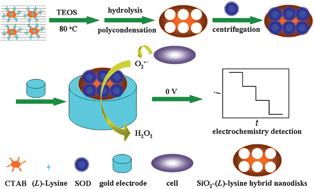Mesoporous SiO2–(l)-lysine hybrid nanodisks: direct electron transfer of superoxide dismutase, sensitive detection of superoxide anions and its application in living cell monitoring
Abstract
The mesoporous SiO2–

* Corresponding authors
a
Jiangsu Key Laboratory of Biofunctional Materials, College of Chemistry and Materials Science, Nanjing Normal University, Nanjing 210023, P. R. China
E-mail:
baojianchun@njnu.edu.cn, daizhihuii@njnu.edu.cn
Fax: +86-25-85891051
Tel: +86-25-85891051
The mesoporous SiO2–

 Please wait while we load your content...
Something went wrong. Try again?
Please wait while we load your content...
Something went wrong. Try again?
M. Han, P. Guo, X. Wang, W. Tu, J. Bao and Z. Dai, RSC Adv., 2013, 3, 20456 DOI: 10.1039/C3RA42403K
To request permission to reproduce material from this article, please go to the Copyright Clearance Center request page.
If you are an author contributing to an RSC publication, you do not need to request permission provided correct acknowledgement is given.
If you are the author of this article, you do not need to request permission to reproduce figures and diagrams provided correct acknowledgement is given. If you want to reproduce the whole article in a third-party publication (excluding your thesis/dissertation for which permission is not required) please go to the Copyright Clearance Center request page.
Read more about how to correctly acknowledge RSC content.
 Fetching data from CrossRef.
Fetching data from CrossRef.
This may take some time to load.
Loading related content
